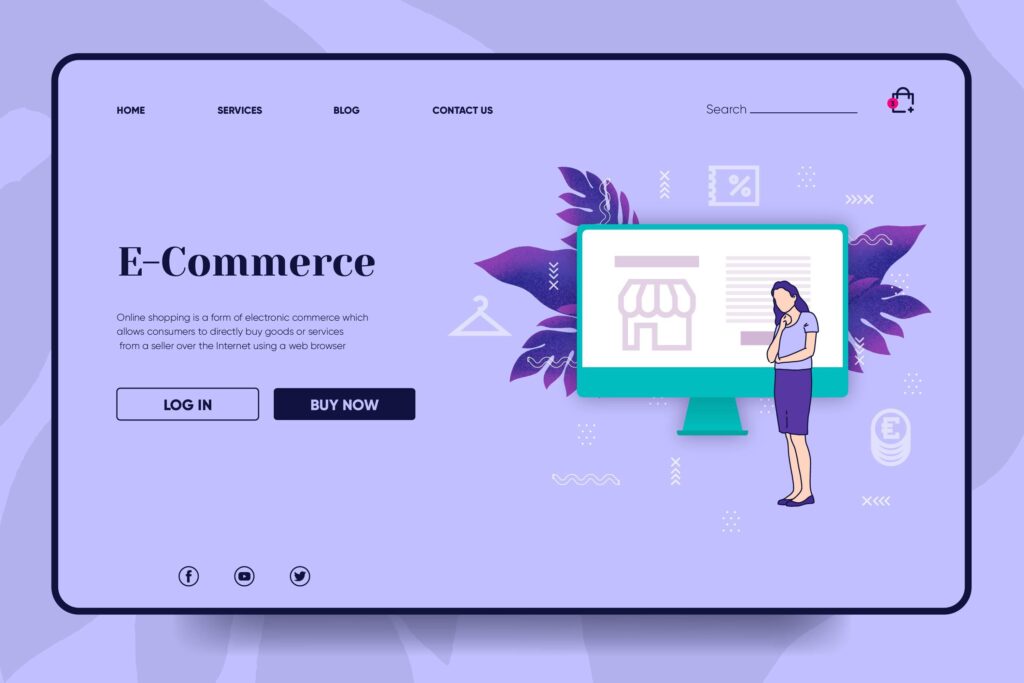An ecommerce website is a platform on the internet that allows businesses to sell products or services online. It typically includes features such as product listings, shopping cart functionality, secure payment processing, and often additional features like customer reviews, order tracking, and account management.

By incorporating these additional strategies into your e-commerce marketing efforts, you can further expand your reach, attract qualified traffic, and drive meaningful engagement with your target audience.
1.Search Engine Optimization (SEO):
Optimizing your website for search engines is crucial for attracting organic traffic. Conduct keyword research to identify terms and phrases relevant to your products, and strategically incorporate them into your website’s content, meta tags, and product descriptions. Regularly publishing high-quality, keyword-rich content such as blog posts, product guides, and tutorials can also help improve your search engine rankings.
2.Content Marketing:
Content is king in the realm of online marketing. Create compelling, informative content that resonates with your target audience and promotes engagement. This could include blog posts, videos, infographics, and social media posts. By consistently providing valuable content, you can attract and retain visitors while establishing your brand as an authority in your niche.
3.Social Media Marketing:
Harness the power of social media to drive traffic to your e-commerce website. Identify the platforms where your target audience is most active and establish a strong presence there. Share engaging content, run targeted ad campaigns, and interact with your followers to build relationships and encourage them to visit your website. Utilize features like shoppable posts and Instagram Stories to make it easy for users to discover and purchase your products directly from social media.
4.Email Marketing:
Email remains one of the most effective channels for driving traffic and converting leads into customers. Build an email list of subscribers who have opted in to receive communications from your brand, and regularly send them personalized, relevant content and promotions. Use enticing subject lines and compelling calls-to-action to encourage recipients to click through to your website.
5. Influencer Partnerships:
Collaborating with influencers in your industry can help expose your brand to a wider audience and drive traffic to your e-commerce website. Identify influencers whose values align with your brand and whose followers match your target demographic. Partner with them to create sponsored content, host giveaways, or offer exclusive discounts to their audience.
6.Paid Advertising:
While organic traffic is valuable, sometimes you need to invest in paid advertising to give your website a boost. Platforms like Google Ads and Facebook Ads allow you to target specific demographics, interests, and behaviors, ensuring that your ads are seen by the right people. Experiment with different ad formats and targeting options to maximize your return on investment.
7. Referral Programs:
Encourage your existing customers to refer their friends and family to your e-commerce website by offering incentives such as discounts, freebies, or loyalty points. Implement a referral program that rewards both the referrer and the new customer, and make it easy for customers to share their unique referral links via email, social media, or messaging apps.
8.Retargeting Campaigns:
Implement retargeting campaigns to re-engage visitors who have previously visited your website but did not make a purchase. Use cookies to track these visitors as they browse the web, and display targeted ads to remind them of the products they viewed or abandoned in their shopping carts. By staying top-of-mind and offering personalized incentives, you can encourage them to return and complete their purchase.
9.User-generated Content:
Leverage user-generated content (UGC) to showcase your products in real-world settings and foster a sense of community around your brand. Encourage satisfied customers to share photos, reviews, and testimonials on social media, and feature this content prominently on your website. UGC not only adds authenticity to your brand but also acts as social proof, influencing potential customers to visit your website and make a purchase.
10.Mobile Optimization:
With the increasing prevalence of smartphones and tablets, optimizing your e-commerce website for mobile devices is no longer optional – it’s essential. Ensure that your website is mobile-responsive, meaning it adapts seamlessly to different screen sizes and devices. Improve page load times, simplify navigation, and streamline the checkout process to provide a frictionless mobile shopping experience. Additionally, consider developing a dedicated mobile app for your e-commerce store to further enhance engagement and drive repeat visits.
An ecommerce website is an online platform specifically designed for businesses to conduct commercial transactions electronically over the internet. It serves as a virtual marketplace where consumers can browse, select, and purchase products or services conveniently from the comfort of their homes or anywhere with internet access.

11.Collaborations and Cross-Promotions:
Form strategic partnerships with complementary brands or businesses to reach new audiences and drive traffic to your e-commerce website. Collaborate on co-branded products, exclusive bundles, or joint marketing campaigns that offer mutual benefits to both parties. Cross-promote each other’s products to your respective customer bases through email newsletters, social media shoutouts, and blog mentions, amplifying your reach and driving traffic from related industries or niches.
12.Local SEO and Google My Business:
If you have a physical storefront or serve customers in specific geographical locations, optimize your e-commerce website for local search. Claim and optimize your Google My Business listing with accurate business information, including your address, phone number, and operating hours. Encourage satisfied customers to leave positive reviews on Google, and target local keywords in your website’s content and meta tags to improve your visibility in local search results. Additionally, consider hosting local events or sponsoring community initiatives to increase brand awareness and drive foot traffic to your physical location.
13.Interactive and Personalized Experiences:
Enhance the shopping experience on your e-commerce website by incorporating interactive elements and personalized recommendations. Implement features such as product quizzes, virtual try-ons, or augmented reality (AR) experiences to engage visitors and help them discover products tailored to their preferences and needs. Use data-driven algorithms to deliver personalized product recommendations based on past purchases, browsing history, and demographic information, increasing the likelihood of conversion and repeat visits.
14.Content Syndication and Guest Posting:
Expand your reach and attract new visitors by syndicating your content on relevant third-party websites or contributing guest posts to industry publications and blogs. Look for reputable websites and blogs that cater to your target audience and offer to share your expertise through informative articles or blog posts. Include a brief bio or author profile with a link back to your e-commerce website to drive traffic from these external sources.
15.Strategic Use of Pop-ups and Exit Intent Offers:
Deploy strategic pop-ups and exit-intent offers on your e-commerce website to capture the attention of visitors before they leave. Offer discounts, freebies, or exclusive content in exchange for email sign-ups or social media follows. Use compelling copy and eye-catching visuals to entice visitors to take action, and ensure that your pop-ups are well-timed and unobtrusive to avoid disrupting the user experience.
16.Affiliate Marketing Programs:
Launch an affiliate marketing program to incentivize influencers, bloggers. And other affiliates to promote your products and drive traffic to your e-commerce website. Offer affiliates a commission or referral fee for every sale generated through their unique tracking links or promo codes. Provide affiliates with marketing materials, tracking tools. And performance incentives to encourage them to actively promote your products to their audience.
17.Online Contests and Giveaways:
Organize online contests, giveaways, or sweepstakes to generate buzz, engage your audience, and drive traffic to your e-commerce website. Encourage participants to take specific actions such as sharing your contest on social media, subscribing to your email list. Or visiting your website to enter or unlock bonus entries. Choose prizes that resonate with your target audience. And align with your brand values to attract qualified leads and potential customers.
18.Continuous Conversion Rate Optimization (CRO):
Implement continuous conversion rate optimization (CRO) strategies to maximize the effectiveness of your website in converting visitors into customers. Conduct A/B tests on various elements of your website, including headlines, call-to-action buttons, product images. And checkout process, to identify areas for improvement and optimize for higher conversion rates. Use heatmaps, user recordings, and other analytical tools to gain insights into user behavior. And preferences, and make data-driven decisions to enhance the user experience and drive conversions.
19.Community Building and Engagement:
Build a loyal community around your brand by fostering meaningful interactions and relationships with your audience. Create online forums, social media groups. Or dedicated communities where customers can connect with each other, share experiences, and provide support. Encourage user-generated content, discussions, and feedback to keep your community engaged and invested in your brand. Offer exclusive perks, rewards, or sneak peeks to community members to incentivize participation and drive traffic to your e-commerce website.
20.Data-driven Remarketing Campaigns:
Utilize data-driven remarketing campaigns to re-engage visitors who have shown interest in your products. But have not yet made a purchase. Segment your audience based on their browsing behavior, shopping preferences. And stage in the purchase funnel, and tailor your remarketing ads and offers accordingly. Use dynamic retargeting ads to display personalized product recommendations. Or abandoned cart reminders to encourage visitors to return to your website and complete their purchase.
Conclusion:
Driving traffic to your e-commerce website requires a multi-faceted approach that encompasses SEO, content marketing. Social media, email marketing, influencer partnerships, paid advertising, and referral programs. By implementing these strategies and continuously optimizing your efforts based on data and feedback. You can attract more visitors, increase sales, and grow your online business. Remember, consistency and patience are key – Rome wasn’t built in a day, and neither is a successful e-commerce empire.
